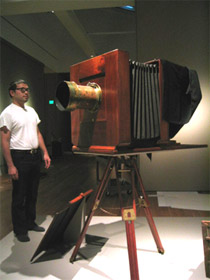 |

The Broken Wave, Sète, 1857
Gustave Le Gray
This 16 by 13-inch print was made with a negative of the same size.
|
 |
Why Such a Big Camera?
Both Gustave Le Gray and Carleton Watkins made large-scale photographs in order to capture the grand scale of their subjects. The most practical way to do this was to increase the size of the camera to produce a negative the same size as the desired print.
Carrying the Equipment into the Field
The large glass plate negatives were prepared with the wet-collodion process—coating the plate with a syrupy solution of silver salt to sensitize the plate to light. Once coated, the glass needed to be exposed and developed immediately. This meant the photographer traveled with a portable darkroom, carting along large quantities of heavy materials.
For his expedition into Yosemite where he took this image, Watkins's equipment consisted of "2,000 lbs of baggage" with enough "glass for over 100 big negatives." Watkins used mules to transport his bulky equipment through the rough and mountainous terrain of Yosemite.
|
 |

Watkins and Le Gray used a camera like this one. Standing more than 5 feet high, it can accomodate glass negatives as big as 18 x 22 inches. 
First View of the Valley, about 1866
Carleton Watkins
13 3/16 x 20 5/8 in. |